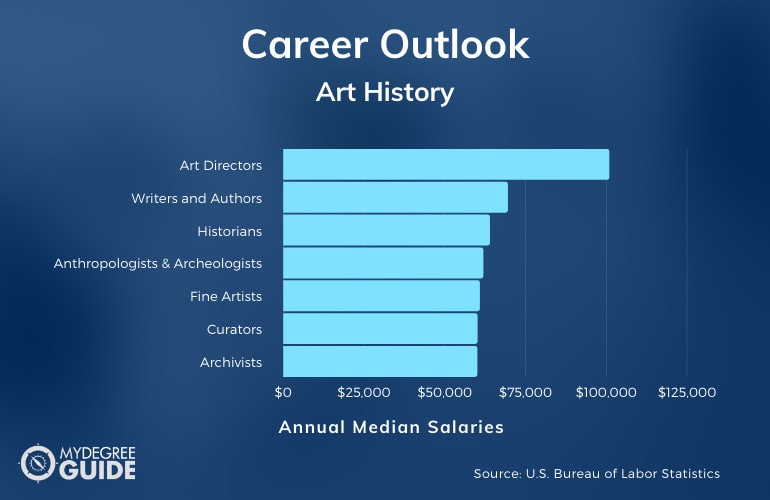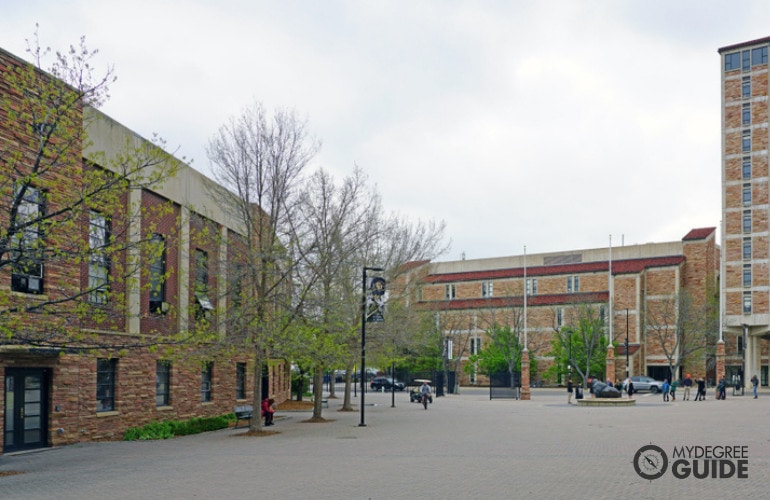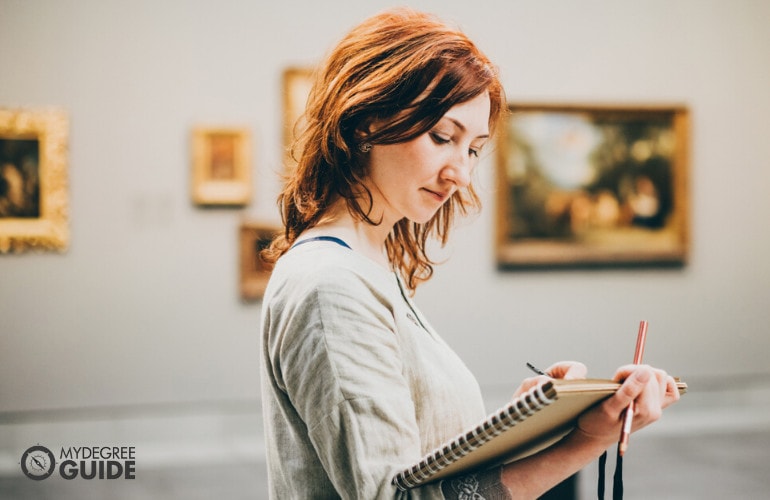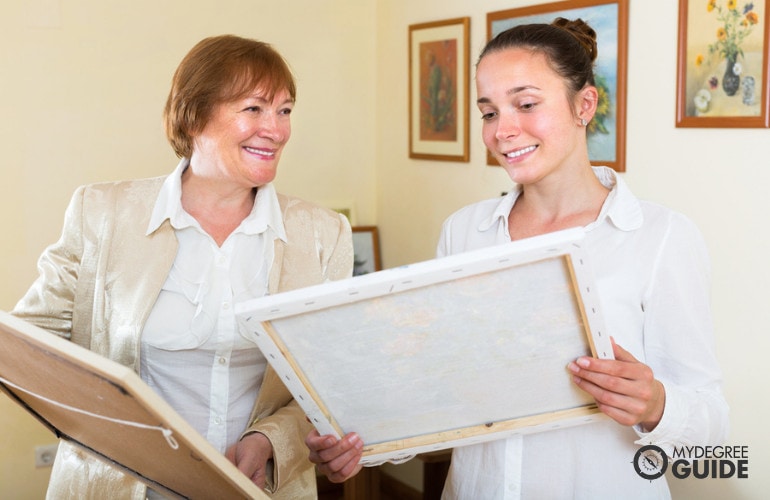If you love learning about art, history, and cultures from around the world, then you may be interested in pursuing an art history associates degree online.

This type of degree could provide you with a foundation in art history and teach you how to contextualize and analyze artwork from different periods and regions.
Editorial Listing ShortCode:
Additionally, online degrees can often be more flexible than traditional degrees, making them a strategic option for students who want to better balance life and education commitments.
Universities Offering Online Associates in Art History Degree Program
Methodology: The following school list is in alphabetical order. To be included, a college or university must be regionally accredited and offer degree programs online or in a hybrid format.
Cerro Coso Community College
Cerro Coso Community College offers an Associate in Art History. It is intended for students who plan to transfer into the California State University System to pursue their bachelor’s upon achievement of their AA degree. The curriculum includes a comprehensive survey of art across cultures and opportunities to practice their artistry in diverse media.
Cerro Coso Community College is accredited by the Accrediting Commission for Community and Junior Colleges of the Western Association of Schools and Colleges.
City College of San Francisco
City College of San Francisco offers an Associate in Art History. Graduates of the program often become art journalists, publishers, librarians, teachers, and therapists. After completing this 2 year degree, students are eligible to transfer into the university system and work toward a bachelor’s degree.
City College of San Francisco is accredited by the Accrediting Commission for Community and Junior Colleges of the Western Association of Schools and Colleges.
Colorado Mountain College
The Associate of Arts in Art History at Colorado Mountain College is designed to provide students with foundational knowledge in art history. This 60 credit degree program can typically be completed in 2 years. It is usually taken as a precursor to a bachelor’s degree program. Students who complete an associate with designation (C- or higher) are guaranteed admission within the Colorado University System.
Colorado Mountain College is accredited by the Higher Learning Commission.
Community College of Aurora
Community College of Aurora offers an Associate in Art History. It is designed for students preparing to transfer into 4 year universities to complete their bachelor’s degrees. The curriculum consists of core requirements in arts, humanities, sciences, mathematics, and social and behavioral sciences. After these are completed, students are required to complete courses in their desired disciplines.
CCA is accredited by the Higher Learning Commission.
Community College of Denver
The 2 year Associate of Arts in Art History at Community College of Denver is the first step toward a bachelor’s in art history. After completing general requirements, students in the program are given opportunities to take courses specific to art history. The curriculum includes surveys of world art, cultural anthropology, art appreciation, and instruction in drawing and painting.
CCD is accredited by the Higher Learning Commission.
Foothill College
Foothill College offers an Associate of Arts in Art History. The program is designed to give students foundational awareness of social, political, economic, religious, and art history and prepare them for various careers in the field. Students must complete a minimum of 90 credits to graduate. The curriculum consists of general education requirements, major-specific core courses, major support classes, and chosen electives.
Foothill College is accredited by the Accrediting Commission for Community and Junior Colleges, of the Western Association of Schools and Colleges.
Front Range Community College
Front Range Community College offers an Associate in Art and Art History. The program is designed for those interested in working as artists, photographers, illustrators, art teachers, museum curators, or gallery directors. This 2 year program can be completed fully online or at the Boulder, Larimer, or Westminster campuses.
FRCC is accredited by the Higher Learning Commission.
Midlands Technical College
Midlands Technical College offers an Associate in Arts with an Art Studio concentration. The curriculum is designed to give students a broad introduction to art history, diverse artistic mediums, the art profession, critical-thinking, and how to live a creative life. Students can attend fully online, fully in-person, or with a hybrid virtual and on-campus schedule.
Midlands Technical College is accredited by the Southern Association of Colleges and Schools Commission on Colleges.
Red Rocks Community College
Red Rocks Community College’s Associate of Arts in Art History program seeks to encourage students in their creative, educational, and professional journeys. The program serves students with a wide range of goals, teaching them the fundamentals of several art mediums, art history, art appreciation, and professionalism.
Red Rocks Community College is accredited by the Higher Learning Commission.
University of La Verne
The Associate of Arts at the University of La Verne is offered asynchronously online to give students flexibility in pursuing their education. The curriculum for this 2 year program includes 30 credits of fine art and humanities, social sciences, natural sciences, and written and spoken English courses. These are then followed by 30 credits of electives in the student’s desired discipline.
The University of La Verne is accredited by the Senior College Commission of the Western Association of Schools and Colleges.
Online Associate’s in Art History Degrees

There are a number of online associates in art history degrees that allow you to immerse yourself in this artistic field.
Art history programs can provide you with a comprehensive overview of the field, from prehistoric times to the present. They can help you develop a deeper understanding of the history and origins of various types of art as well as techniques and styles.
Pursuing an education in art history could help you develop various skills, such as analytical thinking, communication, and interpersonal skills. You could also learn how to research and analyze artworks and historical documents. Art history even helps students gain cultural awareness because it evaluates the historical and cultural contexts of works of art from around the world.
Art history programs include courses that evaluate critical art theories, artists, and artworks from different geographical regions. Some of the topics that an art history program might cover include:
- Baroque art
- Survey of Eastern art
- Greco-Roman artifacts
- Introduction to Western philosophy
- European history
- Medieval art
Graduates of art and art history can focus on different artistic areas. An associate’s degree can lay the foundation for furthering your education in liberal arts. Further studies in the discipline may equip learners with techniques to restore artwork, antiques, and artifacts.
Some advanced career paths related to art history include:
- Archeologist
- Anthropologist
- Art teacher
- Curator
- Librarian
- Historian
These positions often require a bachelors or graduate degree. Some art history majors work in historical sites, government institutions, and museums. Others pursue creative ventures in creating various forms of artwork. They might also perform art appraisals.
Since art history covers art, philosophy, literature, and history, it could lay the foundation for a range of further studies and potential roles.
Art and Art History Careers & Salaries

Art history degree programs can equip learners with essential skills in various concentrations. Depending on your education level, you can choose to pursue a professional path, academia, or business opportunities in the world of art.
For instance, craft and fine artists make many forms of art, including paintings, jewelry, and other visual expressions of art. Tour guides take people around historical and cultural sites, explaining the historical context of works of art to audiences.
More advanced positions related to art history, such as anthropologists, historians, and postsecondary teachers, require a graduate degree. According to the Bureau of Labor Statistics, here are various careers related to the study of art history.
| Careers | Annual Median Salaries |
| Art Directors | $100,890 |
| Writers and Authors | $69,510 |
| Historians | $63,940 |
| Anthropologists and Archeologists | $61,910 |
| Fine Artists | $60,820 |
| Curators | $60,110 |
| Archivists | $60,050 |
| Museum Technicians and Conservators | $47,630 |
| Craft Artists | $35,930 |
| Library Technicians and Assistants | $34,050 |
Museum workers organize collections of historical and artistic works and exhibitions. They arrange the transportation of the art and can act as guides to audiences.
Archivists are responsible for preserving historical documents, maps, photographs, and related materials in cultural organizations. Curators often work with for-profit organizations to curate art collections in art spaces. Conservators handle and restore works of art, antiques, and artifacts using specific preservation methods.
Different careers in art and art history require varying education qualifications. For example, while a tour guide could get an entry-level position with an associates degree, most museum positions require a bachelors or masters degree.
Art History AA Curriculum & Courses

Although schools can have different coursework, an art history AA program typically offers a broad coverage of art history and theories. Course topics are usually organized by time period, geographic location, and artistic style.
Here are examples of both core and elective courses that may be found in an art history associate’s degree program:
- Renaissance Art: This course explores great artists of the Renaissance period and their different art forms, such as sculptures, architecture, and paintings.
- Introduction to Asian Art: This course explores Asian art, including ceramics, calligraphy, and other visual art forms, from the ancient era to the early Middle Ages.
- Modern Art: You’ll explore the history of modern art, from the Post-Impressionism period to the present.
- Introduction to Art: This introductory course covers the foundations of art, including art theory, techniques, and terminologies.
- Survey of Art and Civilization: This type of course explores art and civilization from the Prehistoric period to the Middle Ages in the West and places like Mesopotamia and Egypt.
- Cultural Anthropology: This introductory course involves the systematic study of social organizations, technology, language, and material culture.
- Basic Drawing: You’ll get an introduction to the fundamentals of representational drawing, using media like pencils, charcoal, ink, and water.
- Introduction to Digital Art: You’ll explore the fundamentals of digital graphics and learn how to create and manipulate various images.
- Introduction to Photography: This course exposes you to the history, cultural foundations, and aesthetic elements of photography.
- Medieval Art: You’ll explore the architecture, sculptures, and paintings of the Medieval Western world.
Each online art history associate’s degree program offers a different combination of courses. You may have the opportunity to choose a program that covers your exact areas of interest.
How to Choose an Online Associates Degree in Art History Program

With so many institutions offering online associate’s degrees in art history, it might feel challenging to find the right one for you. Here are some factors to consider as you compare program offerings:
- Cost. It can be helpful to first consider your budget. How much can you afford to spend on tuition and fees? When comparing schools’ costs, you might also take each school’s financial aid opportunities into consideration. Online programs can sometimes be less expensive than on-campus programs since they eliminate various campus fees.
- Accreditation. It’s beneficial to check each institution’s accreditation status. Earning a degree from a credible, accredited school ensures that future employers and other institutions will recognize your degree and your college credits.
- Program. You might choose an asynchronous program if you want a more flexible schedule. Synchronous programs are a fitting choice for students who thrive under a more structured schedule.
- Student support services. Internship programs in the field can be advantageous, so you may want to check whether prospective institutions offer them. Mentorship opportunities and accessibility to student support services are also helpful considerations.
- Curriculum. It’s strategic to look for a program that aligns with your interests. Many online programs offer a general education in art history, but if you have specific interests, you may want to look for a program that provides more specialized coursework.
Clarity on what you want to gain from an art history AA degree program can help you choose the online program that’s best for you.
Admissions Requirements

Most colleges offering an AA degree in art history have the following requirements:
- High school or GED diploma
- SAT or ACT scores (only some schools require them)
- Minimum GPA requirement
- Personal statement detailing personal and career goals
It’s strategic to look carefully at each school’s requirements since they can differ. For example, some programs require an application fee and letters of recommendation.
Online AA in Art History Programs Accreditation

Whether you’re choosing an on-campus or online degree program, accreditation is the mark of a credible school. Attending a school that holds regional accreditation can give you confidence in the quality of education you’ll receive.
You can check the accreditation status of your preferred institutions by visiting the website of the Council for Higher Education Accreditation (CHEA). In some instances, employers check the accreditation status of an applicant’s college before making a hiring decision.
Accreditation can also impact your eligibility to transfer credits to another college program. It’s a precondition for certain forms of financial aid as well.
Financial Aid and Scholarships

Since pursuing an associate’s degree is a financial investment, you might want to explore your financial aid options. You can fill out the Free Application for Federal Student Aid (FAFSA) to see if you qualify for federal aid. Common forms of government aid include grants, student loans, and work-study programs.
You might want to seek the services of a financial advisor before opting to finance your learning with a loan. Some schools offer scholarship opportunities based on merit or area of study. Private and public organizations may also have scholarship programs for students who qualify.
In addition, if you plan to work while you attend school, you may want to see if your workplace offers any tuition benefits.
What Is Art History?

Art history is the study of art forms in their historical development and stylistic contexts. Art encompasses a wide range of forms, including paintings, drawings, sculptures, buildings, and photographs.
Art history includes examining the theory and criticism of art, the role of gender in art, and the relationship between art and politics, religion, and society. The study of art history is an important tool for understanding the development of human civilization. It can also provide insights into our own culture and how it has changed over time.
Is Art History Easy?
Art history is often considered an easier subject since it does not require proficiency in math or science. It does still require critical thinking and analysis, though.
Art history majors can learn to look at a piece of art and ask questions about the artist’s intent, the historical context of the work, and the various interpretations scholars have made over time. Students will interact with a lot of information on periods of art from different parts of the world, studying various artists and art forms. To complete this type of degree program, it’s helpful to have an interest in the discipline.
What Can I Do with an Associates Degree in Art History?

Many careers in art history require a bachelors or masters degree at the entry-level. There are positions, though, that you may qualify for with an associates in art history.
For instance, smaller museums may hire museum technicians who hold an associate, especially if they’ve gained experience as an intern. Some graduates harness their art history education to pursue their own artistic endeavors. An AA in Art History can also be a solid foundation for further study in either art history or another liberal arts field.
With experience and higher education, art history majors could venture into teaching at different levels or working with art investment companies, art galleries, and museums. Others utilize their research and communication skills to work in journalism, administration, and publishing.
Is an Associate Degree in Art History in Demand?
An associate degree in art history could lay the foundation for further academic studies in a variety of liberal arts fields. A number of careers related to art history are also in demand. For instance, the Bureau of Labor Statistics projects 19% job growth for archivists, curators, and museum technicians over the next ten years.
An associates in art history online degree could also benefit students who want to work as craft and fine artists. Employment for craft and fine artists is expected to grow 14% over the next ten years, which is faster than average (Bureau of Labor Statistics).
How Long Does It Take to Get an Associate’s in Art History Degree Online?

An associate degree typically requires the completion of 60 credit hours. It generally takes 2 years to complete with full-time study if your program follows a 16 week semester schedule.
Some art history degree online programs offer the option of an 8 week semester schedule. If you opted to learn all year round and pursue the degree full-time, you might be able to complete your program sooner. Individual circumstances can also determine the speed of completion.
Following a more flexible, part-time schedule could allow you to work or engage in other interests while completing your studies, but it may also take you longer to earn your degree.
Is an Art History Associates Degree Worth It?

Yes, an art history associates degree is worth it for many professionals. For starters, you could build a solid foundation for further studies in liberal arts. You can also develop analytical thinking, research, and communication skills, which are valuable in the workforce as well as at higher academic levels.
In addition, art history can be a pathway to many in-demand career opportunities. The Bureau of Labor Statistics indicates that craft and fine artists will see 14% job growth over the next ten years. Museum workers are also expected to see faster than average growth. Some associate’s degree holders opt to use the skills they gain to go into event planning, to organize exhibitions, or to become artists.
Getting Your Associate Degree in Art History Online

Studying art history can help you develop new perspectives about society and different cultures. Interacting with artwork and its various contexts can also improve your research skills, oral and written communication skills, organizational skills, and analytical skills.
With an online associate degree in art history, you are likely to gain valuable knowledge and versatile skills that are applicable in a variety of liberal arts fields. Plus, with many accredited universities now offering distance learning options, including online art history masters degree and bachelors degree options for their art history programs, it has never been easier to get started on your educational journey.
So, why wait? You can explore your options today to find the accredited art history associates program that’s right for you.
